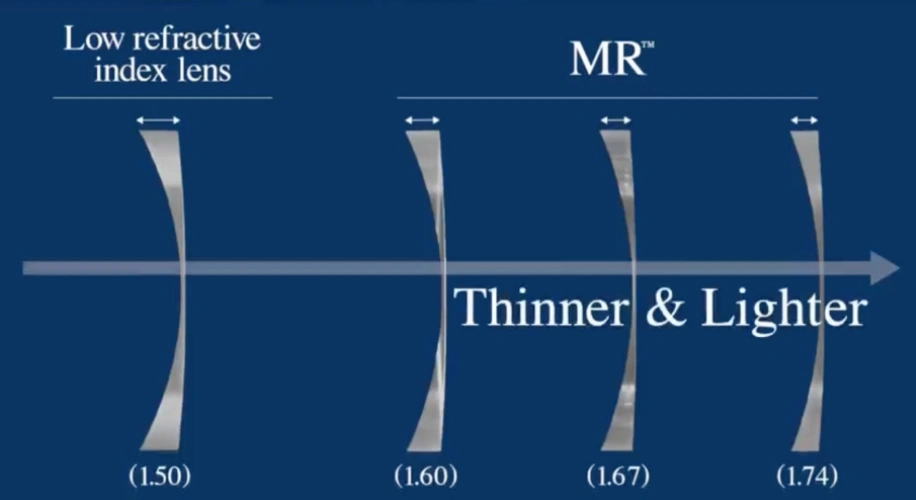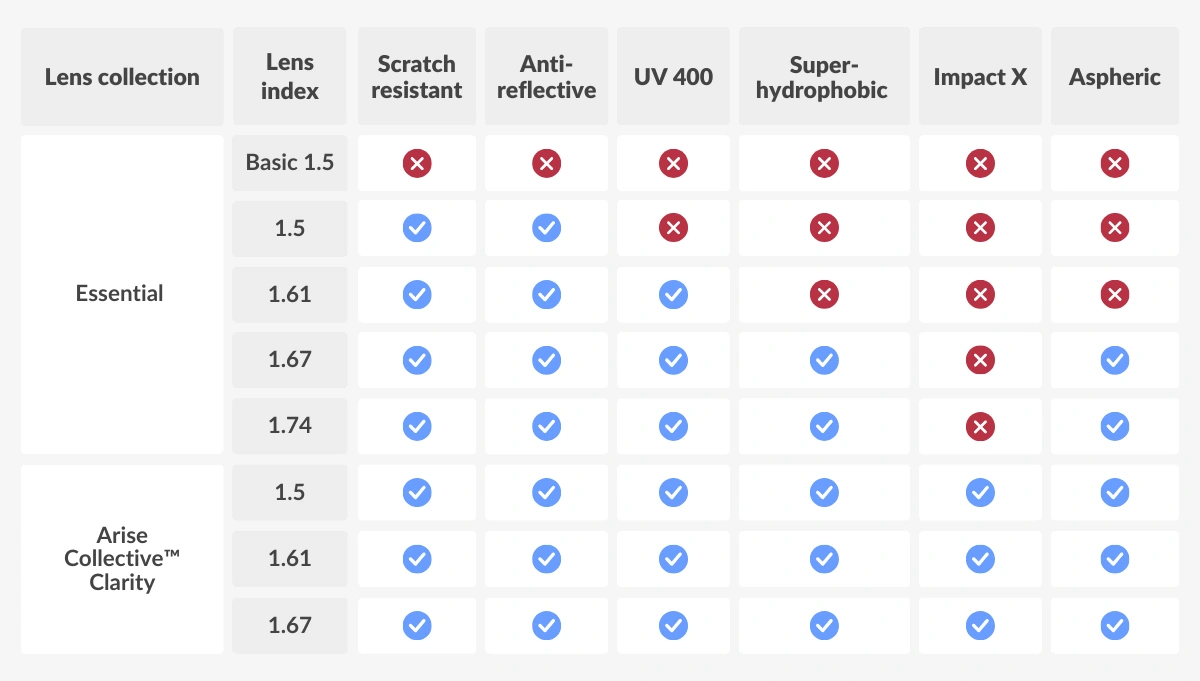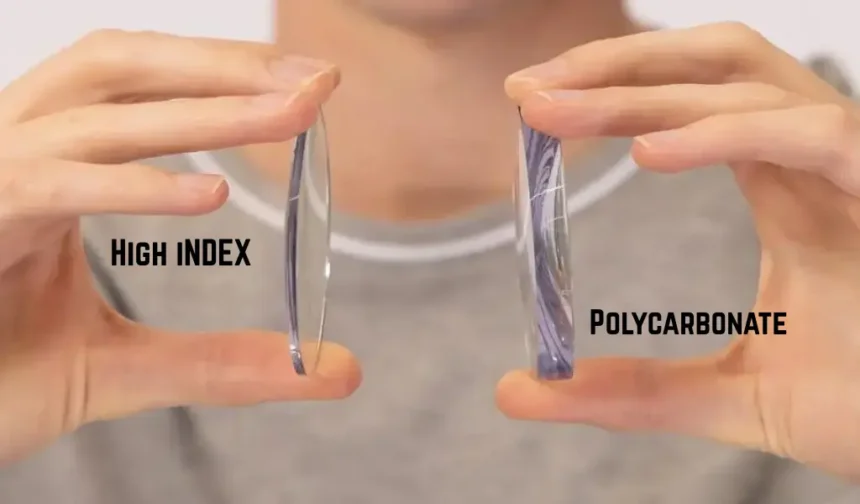If you find yourself seeing the world through heavy, thick glasses, choosing between high index lenses and polycarbonate lenses can make a difference in the comfort and appearance of your glasses. When it comes to lenses for prescriptions above +/-4.00, finding the right lens material is crucial.
High index lenses begin at a refractive index of 1.60, with 1.61, 1.67, and 1.74 options available. It is worth noting that a 1.67 high index lens is able to be 30% thinner than a regular plastic lens.
Conversely, polycarbonate lenses are less refractive at 1.59, but are durable lenses that can withstand 5 times the impact of traditional CR-39 lenses.
This guide is specifically tailored for you to understand your lenses better by highlighting the features that matter in your decision-making, including thickness, weight, durability, visual clarity, and price.
If you prioritize activity, are budget-focused, or just want the thinnest glasses possible, this comparison will help you see clearly both through your lenses and your purchase decision.
Understanding Your Prescription
Before we discuss the various lens options we offer, let us take a moment to explain your prescription. You can think of your prescription as a set of specifications for your glasses—a detailed blueprint for the lenses and how they can help your eyes see.
The figures in your prescription display how much correction you will need in order for your eyes to see clearly.
What Makes a Prescription “Strong”?
When a prescription goes over certain thresholds, it is classified as a “strong prescription.” Typically, a prescription of over 5.00 diopters is deemed strong. This means more than -5.00 for nearsightedness, and more than +5.00 for greater hyperopia or conjunctive supranuclear palsy.
To give you a clearer idea, here is how we classify nearsightedness:
- Mild: -0.25 to -2.00 diopters
- Moderate: -2.25 to -5.00 diopters
- High: Anything stronger than -5.00 diopters
If you’re situated in the “high” prescription category, rest assured you’re in the strong club. The stronger the correction the lenses will give, the higher the value.
Similarly, farsightedness (hyperopia) follows comparable patterns with positive numbers. The further your prescription moves from zero in either direction, the stronger it becomes and the more critical your lens choice becomes.
To put this in perspective, without correction, a -1.00 prescription results in 20/40 vision acuity, while a -5.00 prescription results in 20/400 acuity. Additionally, astigmatism—indicated by cylinder values—can further complicate and strengthen your overall prescription.
Why Lens Material Really Matters When You Have a Strong Prescription
When your prescription is strong, standard lenses get much thicker and heavier, especially at the edges if you’re nearsighted. This extra thickness isn’t just about looks—it can distort your side vision, make your glasses uncomfortable, and limit your frame choices.
High index lenses solve these problems by bending light more efficiently, so they’re much thinner and lighter than regular or polycarbonate lenses for the same prescription.
For example, a 1.67 high-index lens can be up to 30% thinner than standard plastic and about 10% thinner than polycarbonate.
This makes your glasses more comfortable, better looking, and gives you more frame options—especially important as your prescription gets stronger.
High Index Lenses vs. Polycarbonate Lenses: Side-by-Side Comparison

“High index lenses have a higher Abbe value, providing clearer vision with reduced distortion, making them ideal for strong prescriptions requiring precise correction.” — Eyebuydirect Editorial Team, Eyewear industry experts, Eyebuydirect.com
High index lenses and polycarbonate lenses are both popular choices for prescription eyewear, but they serve different needs. Here’s a concise comparison across key factors:
Thickness and Appearance in Frames
- High Index Lenses: With a refractive index starting at 1.60, high index lenses bend light more efficiently, allowing them to be up to 50% thinner than regular plastic lenses. This minimizes the “Coke bottle” look, especially important for strong prescriptions.
- Polycarbonate Lenses: These are about 30% thinner than standard plastic lenses but are usually a bit thicker than high-index options. They still offer a slimmer profile compared to traditional materials.
Weight and Comfort
- High-Index: The material itself is denser, but because less is used, the overall lens can be lighter and more comfortable for stronger prescriptions (over +/-3.00).
- Polycarbonate: Naturally lightweight, making them comfortable for most users. However, for very strong prescriptions, high index lenses may feel lighter overall due to reduced thickness.
Impact Resistance and Safety
- Polycarbonate: The clear winner for safety. Highly impact-resistant, making them ideal for children, sports eyewear, and safety glasses.
- High-Index:More brittle and prone to cracking, so not recommended where durability is a primary concern.
Visual Clarity (Abbe Value)
- High-Index: Abbe values range from 32–42, minimizing color distortion and offering clearer vision, especially with stronger prescriptions.
- Polycarbonate: Lower Abbe value (around 30), which can result in more noticeable color fringing at the lens edges.
Cost
- Polycarbonate: More affordable—typically $50–$60 per pair.
- High-Index: Premium pricing—about $120 for 1.67 index, up to $160 for 1.74 index, but often worth the investment for high prescriptions due to better esthetics and clarity.
Summary Table
| Feature | High-Index | Polycarbonate |
| Thinness | Thinnest | Thin |
| Weight | Lightest (for strong Rx) | Light |
| Impact Resistance | Moderate/Brittle | Very High |
| Visual Clarity | Higher (32–42 Abbe) | Lower (30 Abbe) |
| Cost | Higher | Lower |
| Best For | Strong prescriptions, aesthetics | Safety, kids, sports |
High index lenses excel for strong prescriptions and superior clarity, while polycarbonate is best for impact resistance and budget-friendliness. Choose based on your prescription strength, lifestyle, and safety needs.
When to Choose High Index vs. Polycarbonate Lenses

“Polycarbonate lenses are lighter and more impact-resistant, making them ideal for children and safety glasses.” — POM Material Editorial Team, Optical materials experts, POM Material
Deciding between high-index and polycarbonate lenses depends on your lifestyle, prescription strength, and priorities. Here’s a clear guide to help you choose the best option for your needs.
Best for Kids and Active Lifestyles
Polycarbonate lenses are the top choice here.
- They are lightweight and highly impact-resistant, able to withstand rough play and accidents.
- Many eye care professionals recommend or require polycarbonate lenses for children due to their durability and safety.
- Polycarbonate also offers built-in UV protection, protecting young, developing eyes from harmful rays.
- Ideal for sports, playground activities, and anyone with an active lifestyle.
Best for Fashion and Esthetics
High index lenses shine for those who want sleek, stylish eyewear.
- Their thin and lightweight profile reduces the thick “Coke bottle” look common in strong prescriptions.
- Perfect for rimless, semi-rimless, or minimalist frames, allowing fashion-forward wearers to explore trendy styles confidently.
- Great for strong prescriptions where esthetics and comfort are a priority.
Best for Digital Screen Users
Both lens types benefit from specialized coatings, but:
- Polycarbonate lenses with BlueBuster® or similar blue light filtering protect eyes from harmful blue light emitted by screens without causing a yellow tint.
- Anti-reflective coatings help reduce glare and digital eye strain and work well on both high-index and polycarbonate lenses.
- Choose polycarbonate for added durability plus blue light protection if you’re frequently on digital devices.
Best for Budget-Conscious Buyers
- Polycarbonate lenses generally cost less, making them ideal for families, especially when replacements are more frequent (children, rough use).
- High index lenses are pricier but offer better long-term value for those with strong prescriptions due to improved comfort, thinner lenses, and enhanced esthetics.
Summary Table: When to Choose Each Lens Type
| Scenario | Recommended Lens Type | Why? |
| Kids & Active Lifestyles | Polycarbonate | Superior impact resistance and durability |
| Fashion & Style | High-Index | Thin, lightweight, stylish with strong prescriptions |
| Frequent Screen Use | Polycarbonate + coatings | Blue light filtering without yellow tint |
| Budget Constraints | Polycarbonate | More affordable and durable |
| Strong Prescriptions | High-Index | Thinner, lighter, better esthetics |
If you want, I can help you pick the best lens type based on your exact prescription and daily activities!
Choosing the Right Frame for Your Lens Type
Acetate frames are highly recommended for high prescription lenses. Their thicker, more robust design helps conceal the edges of thicker lenses, providing a cleaner, more polished look. Acetate is also flexible and durable, making it a practical choice for everyday wear.
Translucent colored frames can further blend the lens edge with the frame, creating a seamless appearance.
Avoid thin metal frames for strong prescriptions, as their minimalist design exposes more of the lens edge, making thickness more noticeable.
How to Reduce Lens Thickness with Smart Frame Choices
- Choose smaller frames: Frames with a width of 50–54mm and modest height require less lens material, resulting in thinner lenses.
- Opt for round or oval shapes: These shapes better match the natural curve of the lens, minimizing edge thickness compared to rectangular frames.
- Ensure accurate pupillary distance: Proper alignment is crucial for comfort and clear vision; incorrect measurements can lead to discomfort and blurred sight.
Must-Have Coatings for High Prescription Glasses
- Anti-reflective coating: Essential for both high-index and polycarbonate lenses, this reduces glare and makes your eyes more visible behind the lenses.
- Hard coating: Increases scratch resistance, which is especially important for plastic lenses that are softer than glass.
- CleanCoat or hydrophobic coating: Repels dirt and smudges, making cleaning easier and keeping your lenses clearer for longer.
- UV protection: While most modern lenses include this, double-check to ensure your lenses block 100% of harmful UV rays.
Quick Reference Table
| Customization Tip | Why It Matters |
| Acetate frames | Conceal lens thickness, add durability |
| Smaller, round/oval frames | Reduce lens edge thickness, enhance comfort |
| Accurate measurements | Ensure clear, comfortable vision |
| Anti-reflective coating | Minimize glare, improve appearance |
| Hard coating | Protect against scratches |
| CleanCoat/hydrophobic | Easier cleaning, less smudging |
| UV protection | Safeguard eye health |
For high prescriptions, prioritize acetate frames and smaller, rounder shapes to minimize lens thickness and maximize comfort. Always add essential coatings for durability, clarity, and protection. These choices ensure your glasses look great and perform well in daily life.
Conclusion
Choosing between high index lenses and polycarbonate ultimately depends on your specific needs and lifestyle. While high index lenses excel in thinness and esthetic appeal, polycarbonate stands out for durability and impact resistance.
For prescriptions stronger than +/-4.00, high index lenses typically offer better comfort and appearance despite their higher cost. Conversely, polycarbonate remains the superior choice for children, active adults, and safety applications.
Your frame selection plays an equally important role in optimizing lens appearance. Smaller, rounder frames with acetate construction will significantly reduce edge thickness, particularly for high prescriptions.
Additionally, essential coatings like anti-reflective treatments enhance visual clarity while protecting your investment.
Remember that prescription strength should guide your decision. Those with mild to moderate prescriptions might find polycarbonate perfectly adequate, whereas stronger prescriptions generally benefit more from high index materials.
The extra cost of high index lenses often justifies itself through improved comfort, reduced weight, and better esthetics for daily wear.
Clearer vision and lighter glasses are possible — you just need the right lenses. Make your next pair of glasses your most comfortable yet.
Though budget considerations matter, think of your eyewear as an investment in both your vision and confidence. After all, you wear your glasses every day, therefore comfort and appearance deserve thoughtful consideration.
Whether you prioritize fashion, function, or finding the perfect balance between both, understanding these lens differences empowers you to make smarter choices
. With the right combination of lens material, frame style, and protective coatings, your glasses can finally feel as good as they look.
Key Takeaways
For strong prescriptions (+/-4.00 and higher), choosing the right lens material significantly impacts your daily comfort, appearance, and visual experience.
- High index lenses are 30% thinner than standard lenses, making them ideal for strong prescriptions where esthetics and reduced weight matter most.
- Polycarbonate lenses offer 5x more impact resistance, making them the safest choice for children, active lifestyles, and sports activities.
- High index provides better visual clarity with higher Abbe values (32-42) compared to polycarbonate’s lower value of 30, reducing color distortion.
- Frame selection is crucial – choose smaller, round acetate frames to minimize lens thickness and maximize comfort for any lens type.
- Cost reflects performance – polycarbonate costs around $50-60 while high index ranges $120-160, but the investment pays off for stronger prescriptions.
The decision ultimately comes down to your priorities: choose high index for the thinnest, most attractive glasses, or polycarbonate for maximum durability and safety. Both options dramatically outperform standard plastic lenses for strong prescriptions.
FAQs
Q1. What’s the main difference between high index and polycarbonate lenses for strong prescriptions? High index lenses are thinner and more esthetically pleasing, while polycarbonate lenses offer superior impact resistance. High index is typically better for prescriptions over +/-4.00, while polycarbonate is ideal for active lifestyles and children’s eyewear.
Q2. How do I choose the right frames for thick lenses? Opt for smaller, rounder frames made of acetate material. These frame styles help minimize lens thickness and provide better support for strong prescriptions. Avoid large or rimless frames, as they can accentuate lens thickness.
Q3. At what prescription strength should I consider high index lenses? Generally, prescriptions of +/-4.00 and higher benefit most from high index lenses. For prescriptions between +/-4.00 and +/-8.00, 1.67 high index lenses are recommended. For prescriptions over +/-8.00, consider 1.74 high index lenses for optimal thinness and clarity.
Q4. Are high index lenses worth the extra cost? For strong prescriptions, high index lenses often justify their higher price through improved comfort, reduced weight, and better esthetics. While they cost more upfront, they can provide better long-term value for daily wear, especially if you prioritize appearance and comfort.
Q5. What coatings should I add to my prescription lenses? Anti-reflective coatings are essential for both high index and polycarbonate lenses to reduce glare and improve clarity. Consider adding a hard coating for scratch resistance, especially for plastic lenses. UV protection is also important if not already included in your chosen lens material.







